Analysis of Leadership and Management Functions at Starbucks
VerifiedAdded on 2022/12/28
|6
|1268
|3
Report
AI Summary
This report provides an analysis of leadership and management functions at Starbucks, differentiating between the roles of leaders and managers within the organization. It explores the characteristics of effective leaders and managers, emphasizing their distinct approaches to achieving organizational goals. The report applies various leadership and management theories, such as classical theory, transformational leadership, and transactional leadership, to understand the practical application of these concepts at Starbucks. It examines different leadership styles, including autocratic, democratic, and authoritative approaches, and discusses the functions of management, such as planning, organizing, staffing, directing, and controlling. By comparing and contrasting these elements, the report offers insights into how Starbucks effectively manages its workforce and achieves its business objectives. The analysis also highlights the importance of both soft and hard skills in leadership and management roles within the company, providing a comprehensive overview of the leadership and management dynamics at Starbucks.
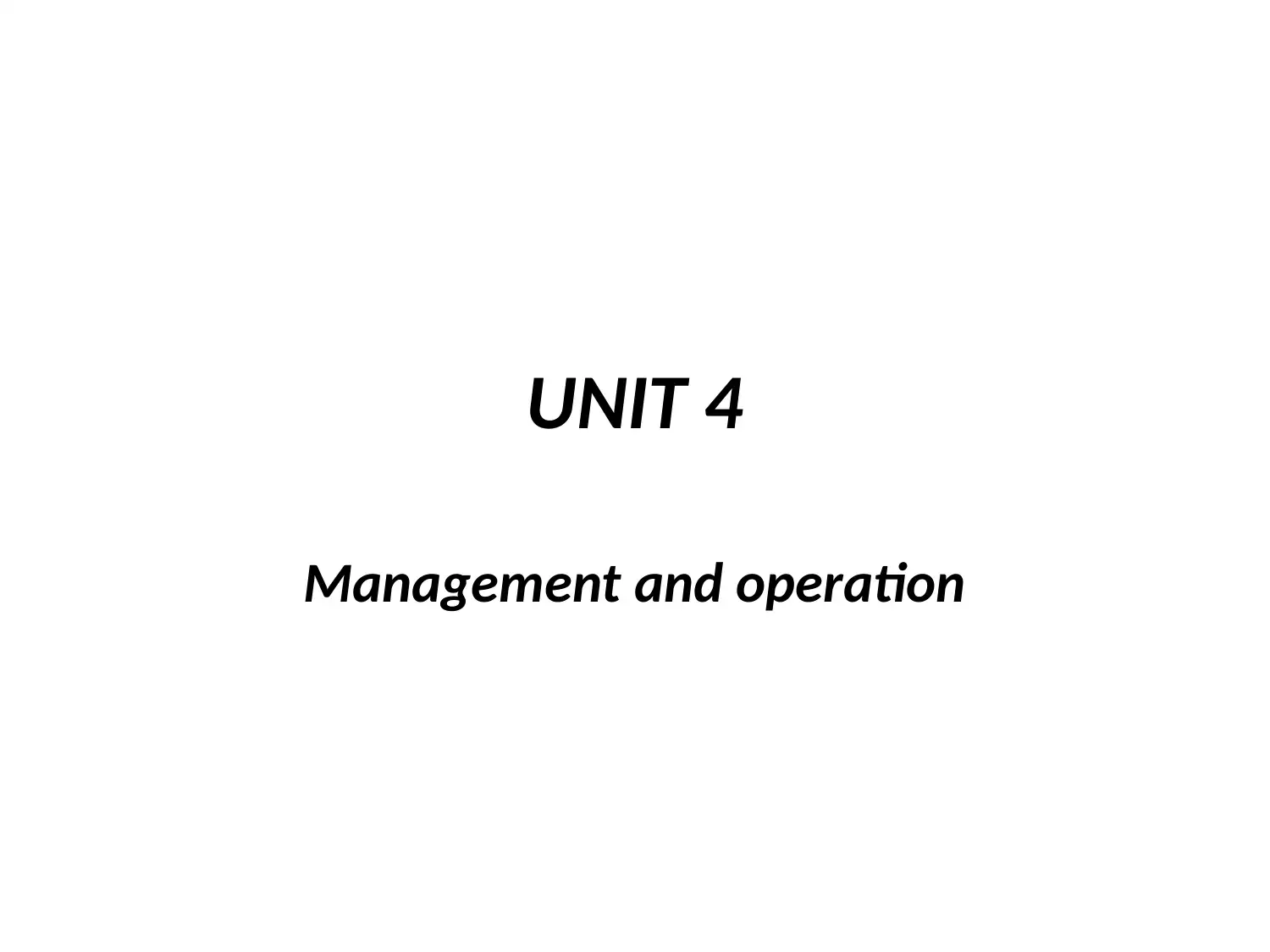
UNIT 4
Management and operation
Management and operation
Paraphrase This Document
Need a fresh take? Get an instant paraphrase of this document with our AI Paraphraser
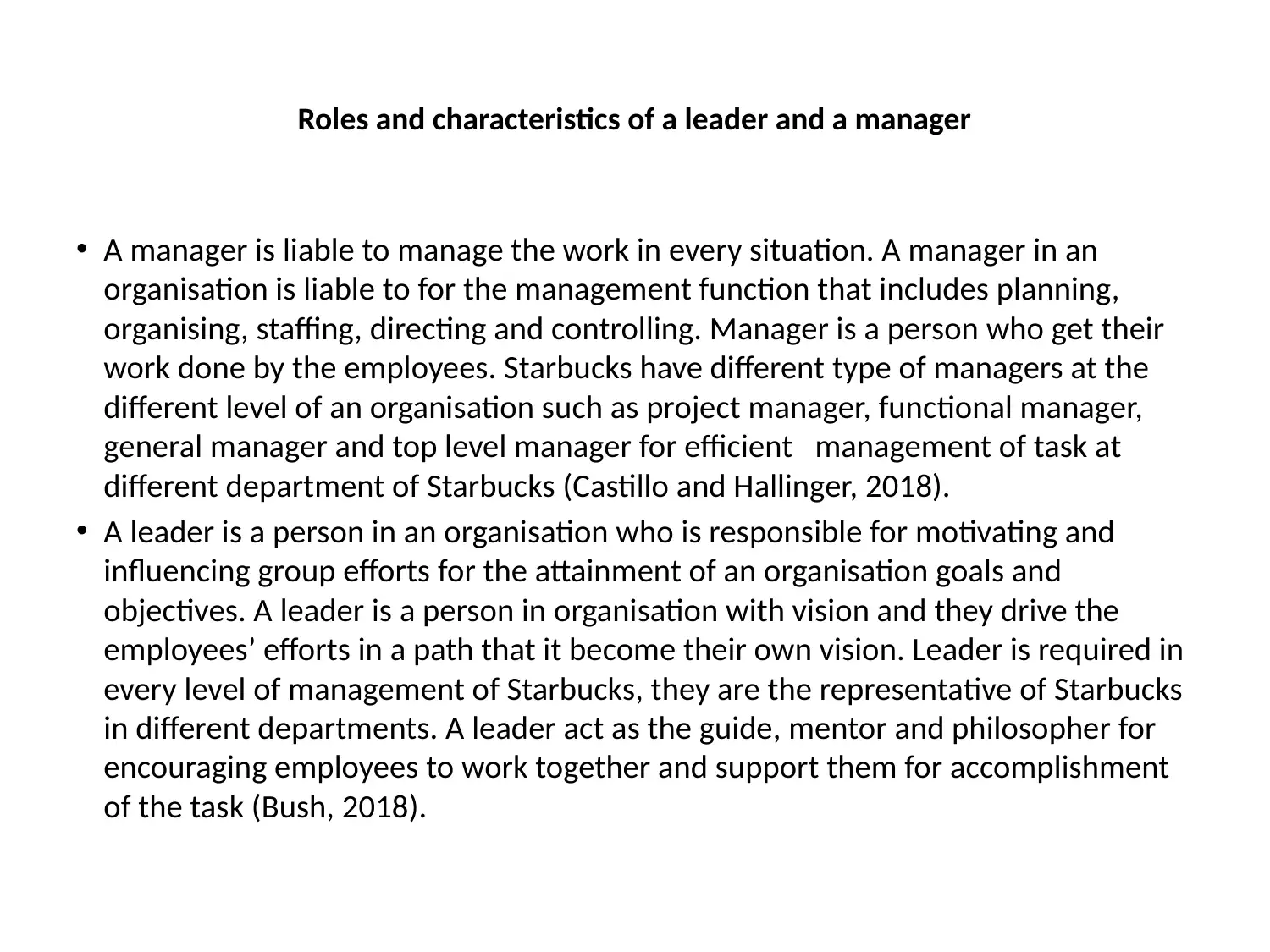
Roles and characteristics of a leader and a manager
• A manager is liable to manage the work in every situation. A manager in an
organisation is liable to for the management function that includes planning,
organising, staffing, directing and controlling. Manager is a person who get their
work done by the employees. Starbucks have different type of managers at the
different level of an organisation such as project manager, functional manager,
general manager and top level manager for efficient management of task at
different department of Starbucks (Castillo and Hallinger, 2018).
• A leader is a person in an organisation who is responsible for motivating and
influencing group efforts for the attainment of an organisation goals and
objectives. A leader is a person in organisation with vision and they drive the
employees’ efforts in a path that it become their own vision. Leader is required in
every level of management of Starbucks, they are the representative of Starbucks
in different departments. A leader act as the guide, mentor and philosopher for
encouraging employees to work together and support them for accomplishment
of the task (Bush, 2018).
• A manager is liable to manage the work in every situation. A manager in an
organisation is liable to for the management function that includes planning,
organising, staffing, directing and controlling. Manager is a person who get their
work done by the employees. Starbucks have different type of managers at the
different level of an organisation such as project manager, functional manager,
general manager and top level manager for efficient management of task at
different department of Starbucks (Castillo and Hallinger, 2018).
• A leader is a person in an organisation who is responsible for motivating and
influencing group efforts for the attainment of an organisation goals and
objectives. A leader is a person in organisation with vision and they drive the
employees’ efforts in a path that it become their own vision. Leader is required in
every level of management of Starbucks, they are the representative of Starbucks
in different departments. A leader act as the guide, mentor and philosopher for
encouraging employees to work together and support them for accomplishment
of the task (Bush, 2018).
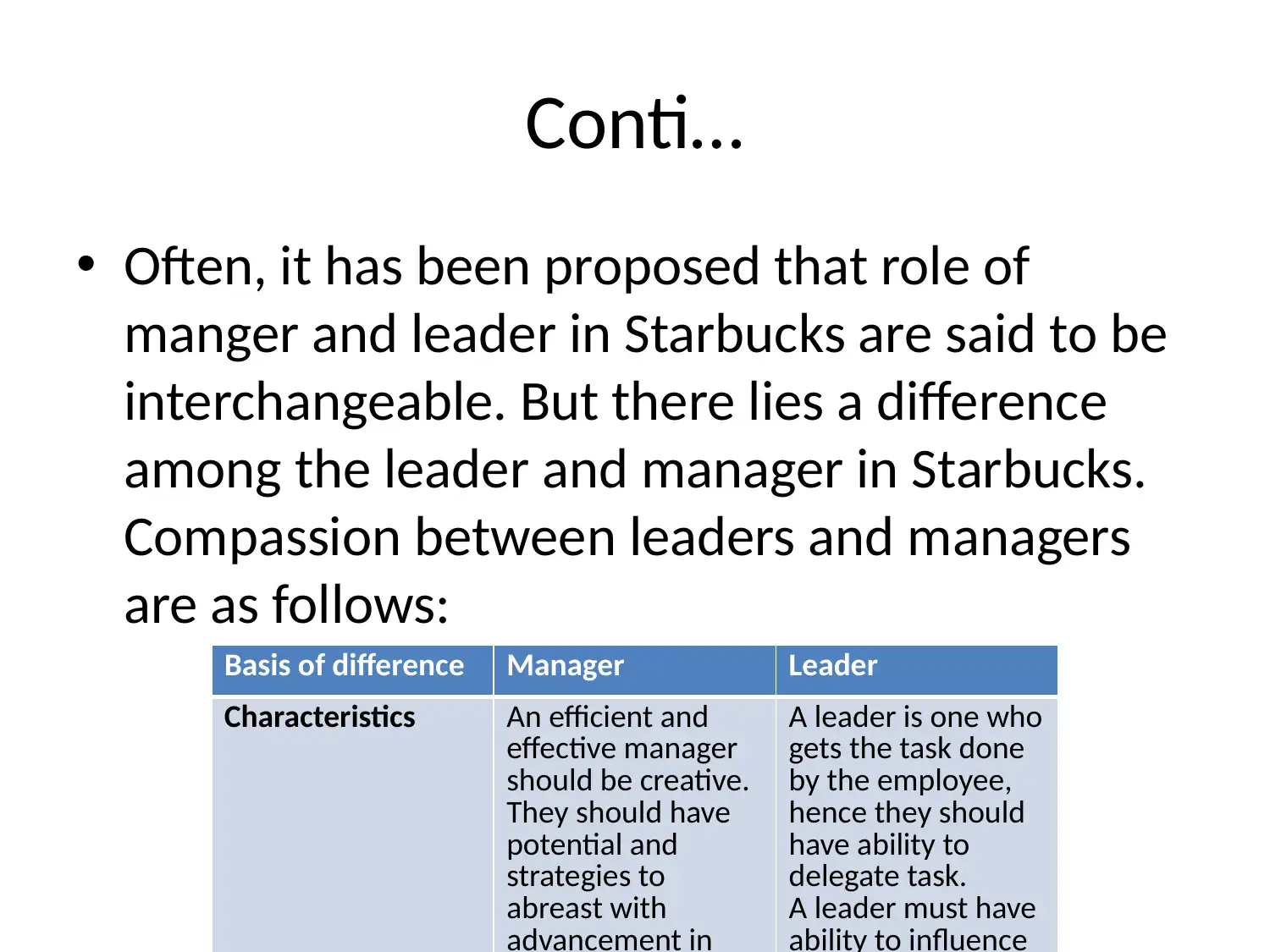
Conti…
• Often, it has been proposed that role of
manger and leader in Starbucks are said to be
interchangeable. But there lies a difference
among the leader and manager in Starbucks.
Compassion between leaders and managers
are as follows:
Basis of difference Manager Leader
Characteristics An efficient and
effective manager
should be creative.
They should have
potential and
strategies to
abreast with
advancement in
A leader is one who
gets the task done
by the employee,
hence they should
have ability to
delegate task.
A leader must have
ability to influence
• Often, it has been proposed that role of
manger and leader in Starbucks are said to be
interchangeable. But there lies a difference
among the leader and manager in Starbucks.
Compassion between leaders and managers
are as follows:
Basis of difference Manager Leader
Characteristics An efficient and
effective manager
should be creative.
They should have
potential and
strategies to
abreast with
advancement in
A leader is one who
gets the task done
by the employee,
hence they should
have ability to
delegate task.
A leader must have
ability to influence
⊘ This is a preview!⊘
Do you want full access?
Subscribe today to unlock all pages.

Trusted by 1+ million students worldwide
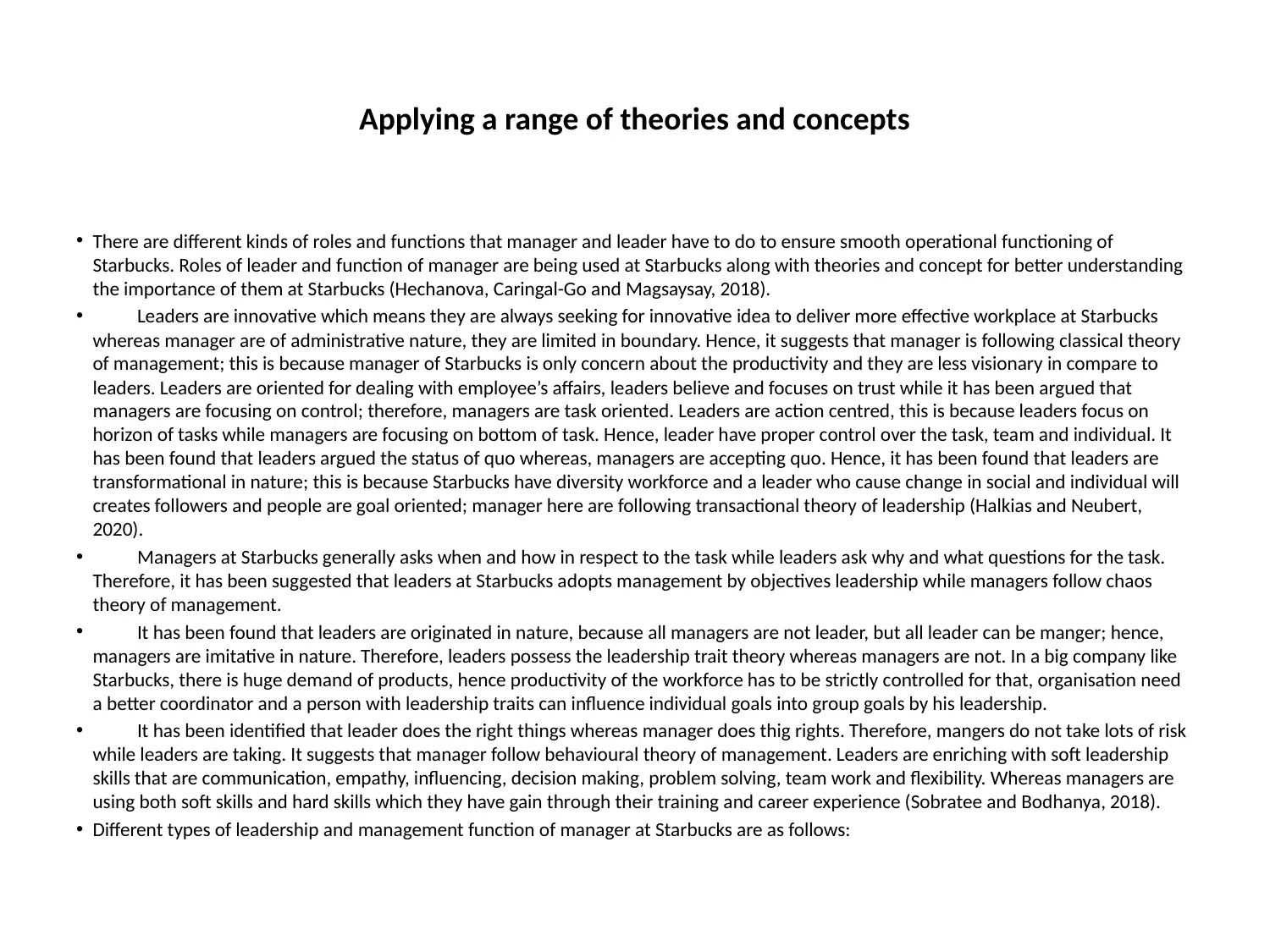
Applying a range of theories and concepts
• There are different kinds of roles and functions that manager and leader have to do to ensure smooth operational functioning of
Starbucks. Roles of leader and function of manager are being used at Starbucks along with theories and concept for better understanding
the importance of them at Starbucks (Hechanova, Caringal-Go and Magsaysay, 2018).
• Leaders are innovative which means they are always seeking for innovative idea to deliver more effective workplace at Starbucks
whereas manager are of administrative nature, they are limited in boundary. Hence, it suggests that manager is following classical theory
of management; this is because manager of Starbucks is only concern about the productivity and they are less visionary in compare to
leaders. Leaders are oriented for dealing with employee’s affairs, leaders believe and focuses on trust while it has been argued that
managers are focusing on control; therefore, managers are task oriented. Leaders are action centred, this is because leaders focus on
horizon of tasks while managers are focusing on bottom of task. Hence, leader have proper control over the task, team and individual. It
has been found that leaders argued the status of quo whereas, managers are accepting quo. Hence, it has been found that leaders are
transformational in nature; this is because Starbucks have diversity workforce and a leader who cause change in social and individual will
creates followers and people are goal oriented; manager here are following transactional theory of leadership (Halkias and Neubert,
2020).
• Managers at Starbucks generally asks when and how in respect to the task while leaders ask why and what questions for the task.
Therefore, it has been suggested that leaders at Starbucks adopts management by objectives leadership while managers follow chaos
theory of management.
• It has been found that leaders are originated in nature, because all managers are not leader, but all leader can be manger; hence,
managers are imitative in nature. Therefore, leaders possess the leadership trait theory whereas managers are not. In a big company like
Starbucks, there is huge demand of products, hence productivity of the workforce has to be strictly controlled for that, organisation need
a better coordinator and a person with leadership traits can influence individual goals into group goals by his leadership.
• It has been identified that leader does the right things whereas manager does thig rights. Therefore, mangers do not take lots of risk
while leaders are taking. It suggests that manager follow behavioural theory of management. Leaders are enriching with soft leadership
skills that are communication, empathy, influencing, decision making, problem solving, team work and flexibility. Whereas managers are
using both soft skills and hard skills which they have gain through their training and career experience (Sobratee and Bodhanya, 2018).
• Different types of leadership and management function of manager at Starbucks are as follows:
• There are different kinds of roles and functions that manager and leader have to do to ensure smooth operational functioning of
Starbucks. Roles of leader and function of manager are being used at Starbucks along with theories and concept for better understanding
the importance of them at Starbucks (Hechanova, Caringal-Go and Magsaysay, 2018).
• Leaders are innovative which means they are always seeking for innovative idea to deliver more effective workplace at Starbucks
whereas manager are of administrative nature, they are limited in boundary. Hence, it suggests that manager is following classical theory
of management; this is because manager of Starbucks is only concern about the productivity and they are less visionary in compare to
leaders. Leaders are oriented for dealing with employee’s affairs, leaders believe and focuses on trust while it has been argued that
managers are focusing on control; therefore, managers are task oriented. Leaders are action centred, this is because leaders focus on
horizon of tasks while managers are focusing on bottom of task. Hence, leader have proper control over the task, team and individual. It
has been found that leaders argued the status of quo whereas, managers are accepting quo. Hence, it has been found that leaders are
transformational in nature; this is because Starbucks have diversity workforce and a leader who cause change in social and individual will
creates followers and people are goal oriented; manager here are following transactional theory of leadership (Halkias and Neubert,
2020).
• Managers at Starbucks generally asks when and how in respect to the task while leaders ask why and what questions for the task.
Therefore, it has been suggested that leaders at Starbucks adopts management by objectives leadership while managers follow chaos
theory of management.
• It has been found that leaders are originated in nature, because all managers are not leader, but all leader can be manger; hence,
managers are imitative in nature. Therefore, leaders possess the leadership trait theory whereas managers are not. In a big company like
Starbucks, there is huge demand of products, hence productivity of the workforce has to be strictly controlled for that, organisation need
a better coordinator and a person with leadership traits can influence individual goals into group goals by his leadership.
• It has been identified that leader does the right things whereas manager does thig rights. Therefore, mangers do not take lots of risk
while leaders are taking. It suggests that manager follow behavioural theory of management. Leaders are enriching with soft leadership
skills that are communication, empathy, influencing, decision making, problem solving, team work and flexibility. Whereas managers are
using both soft skills and hard skills which they have gain through their training and career experience (Sobratee and Bodhanya, 2018).
• Different types of leadership and management function of manager at Starbucks are as follows:
Paraphrase This Document
Need a fresh take? Get an instant paraphrase of this document with our AI Paraphraser
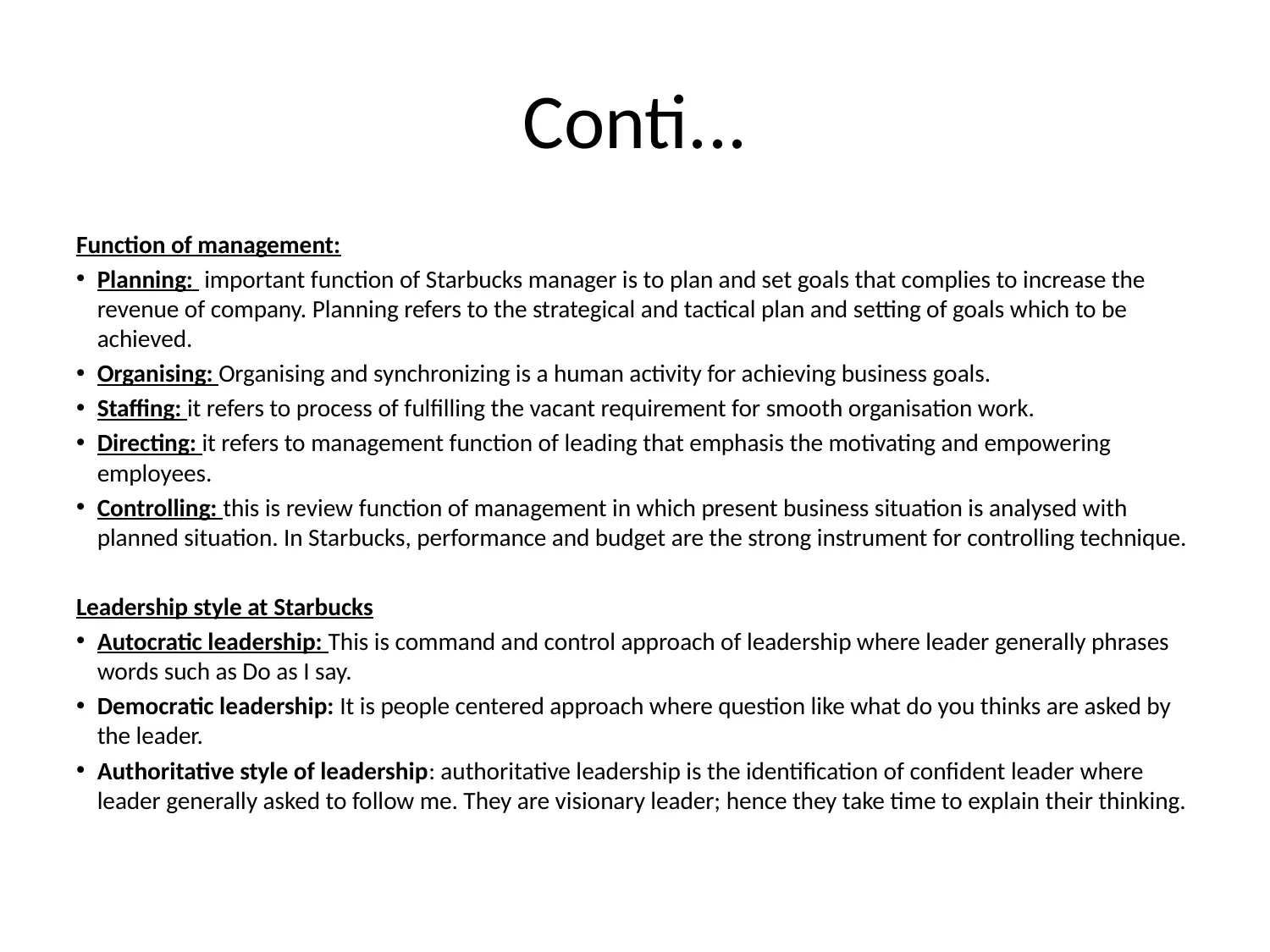
Conti...
Function of management:
• Planning: important function of Starbucks manager is to plan and set goals that complies to increase the
revenue of company. Planning refers to the strategical and tactical plan and setting of goals which to be
achieved.
• Organising: Organising and synchronizing is a human activity for achieving business goals.
• Staffing: it refers to process of fulfilling the vacant requirement for smooth organisation work.
• Directing: it refers to management function of leading that emphasis the motivating and empowering
employees.
• Controlling: this is review function of management in which present business situation is analysed with
planned situation. In Starbucks, performance and budget are the strong instrument for controlling technique.
Leadership style at Starbucks
• Autocratic leadership: This is command and control approach of leadership where leader generally phrases
words such as Do as I say.
• Democratic leadership: It is people centered approach where question like what do you thinks are asked by
the leader.
• Authoritative style of leadership: authoritative leadership is the identification of confident leader where
leader generally asked to follow me. They are visionary leader; hence they take time to explain their thinking.
Function of management:
• Planning: important function of Starbucks manager is to plan and set goals that complies to increase the
revenue of company. Planning refers to the strategical and tactical plan and setting of goals which to be
achieved.
• Organising: Organising and synchronizing is a human activity for achieving business goals.
• Staffing: it refers to process of fulfilling the vacant requirement for smooth organisation work.
• Directing: it refers to management function of leading that emphasis the motivating and empowering
employees.
• Controlling: this is review function of management in which present business situation is analysed with
planned situation. In Starbucks, performance and budget are the strong instrument for controlling technique.
Leadership style at Starbucks
• Autocratic leadership: This is command and control approach of leadership where leader generally phrases
words such as Do as I say.
• Democratic leadership: It is people centered approach where question like what do you thinks are asked by
the leader.
• Authoritative style of leadership: authoritative leadership is the identification of confident leader where
leader generally asked to follow me. They are visionary leader; hence they take time to explain their thinking.
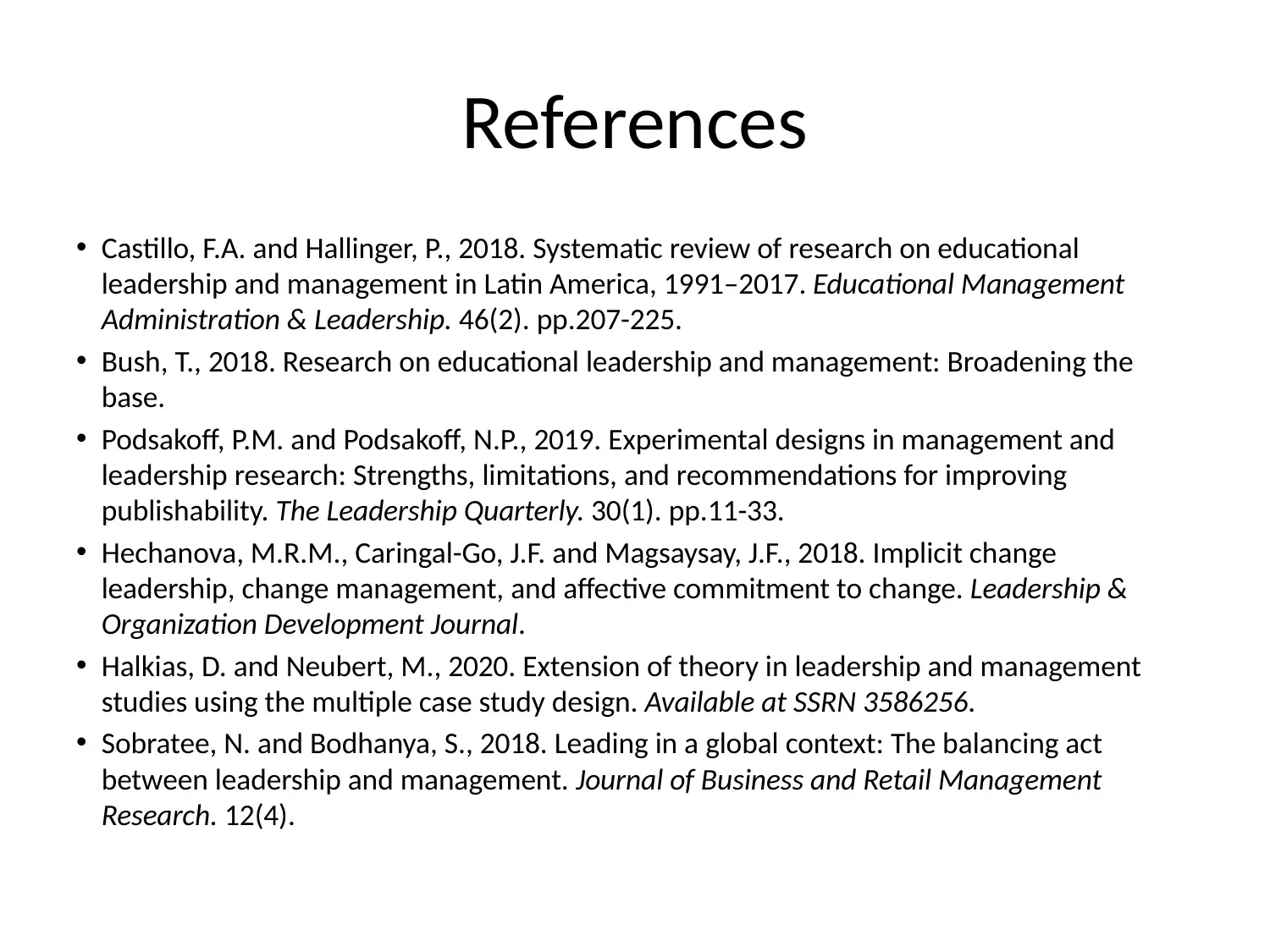
References
• Castillo, F.A. and Hallinger, P., 2018. Systematic review of research on educational
leadership and management in Latin America, 1991–2017. Educational Management
Administration & Leadership. 46(2). pp.207-225.
• Bush, T., 2018. Research on educational leadership and management: Broadening the
base.
• Podsakoff, P.M. and Podsakoff, N.P., 2019. Experimental designs in management and
leadership research: Strengths, limitations, and recommendations for improving
publishability. The Leadership Quarterly. 30(1). pp.11-33.
• Hechanova, M.R.M., Caringal-Go, J.F. and Magsaysay, J.F., 2018. Implicit change
leadership, change management, and affective commitment to change. Leadership &
Organization Development Journal.
• Halkias, D. and Neubert, M., 2020. Extension of theory in leadership and management
studies using the multiple case study design. Available at SSRN 3586256.
• Sobratee, N. and Bodhanya, S., 2018. Leading in a global context: The balancing act
between leadership and management. Journal of Business and Retail Management
Research. 12(4).
• Castillo, F.A. and Hallinger, P., 2018. Systematic review of research on educational
leadership and management in Latin America, 1991–2017. Educational Management
Administration & Leadership. 46(2). pp.207-225.
• Bush, T., 2018. Research on educational leadership and management: Broadening the
base.
• Podsakoff, P.M. and Podsakoff, N.P., 2019. Experimental designs in management and
leadership research: Strengths, limitations, and recommendations for improving
publishability. The Leadership Quarterly. 30(1). pp.11-33.
• Hechanova, M.R.M., Caringal-Go, J.F. and Magsaysay, J.F., 2018. Implicit change
leadership, change management, and affective commitment to change. Leadership &
Organization Development Journal.
• Halkias, D. and Neubert, M., 2020. Extension of theory in leadership and management
studies using the multiple case study design. Available at SSRN 3586256.
• Sobratee, N. and Bodhanya, S., 2018. Leading in a global context: The balancing act
between leadership and management. Journal of Business and Retail Management
Research. 12(4).
⊘ This is a preview!⊘
Do you want full access?
Subscribe today to unlock all pages.

Trusted by 1+ million students worldwide
1 out of 6
Related Documents
Your All-in-One AI-Powered Toolkit for Academic Success.
+13062052269
info@desklib.com
Available 24*7 on WhatsApp / Email
![[object Object]](/_next/static/media/star-bottom.7253800d.svg)
Unlock your academic potential
Copyright © 2020–2025 A2Z Services. All Rights Reserved. Developed and managed by ZUCOL.





